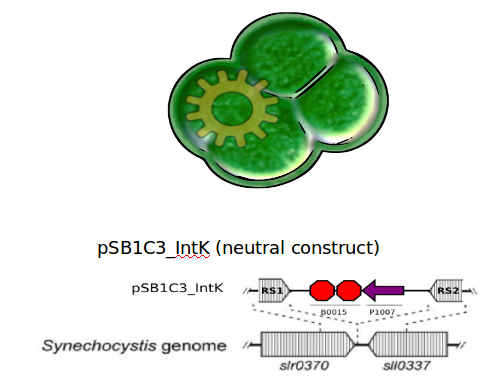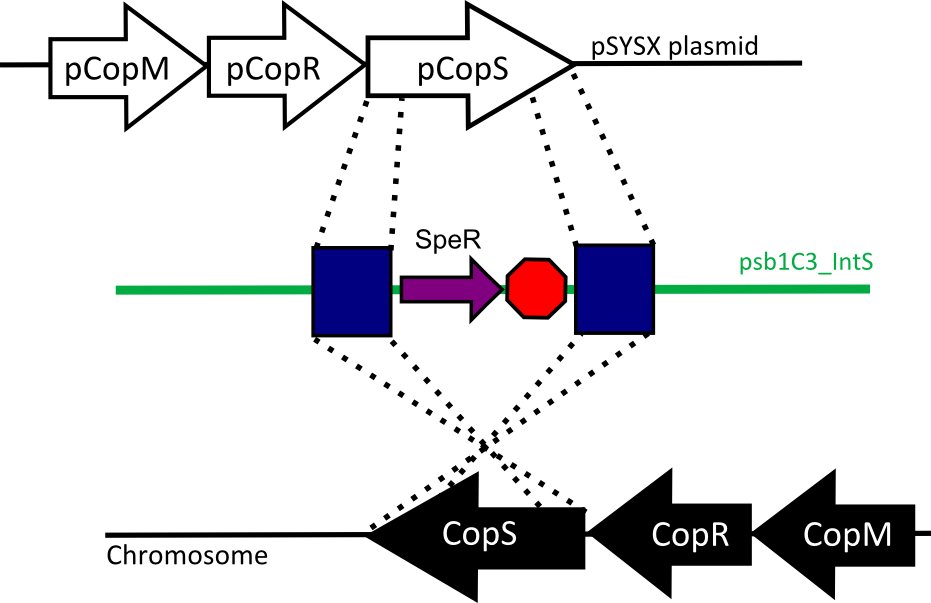Team:UC Chile/Cyanolux/Project short
From 2012.igem.org
(Difference between revisions)
Juan Alamos (Talk | contribs) |
|||
| Line 3: | Line 3: | ||
<h1>Main Goal:</h1> | <h1>Main Goal:</h1> | ||
| - | Our project consists on achieving bioluminescence controlled under circadian rhythms with long-term functionality. Our aim is to produce a bioluminescent cyanobacteria which lights up during dusk hours and | + | Our project consists on achieving bioluminescence controlled under circadian rhythms with long-term functionality. Our aim is to produce a bioluminescent cyanobacteria which lights up during dusk hours and regenerates the substrates during the day. |
<h2>Rationale:</h2> | <h2>Rationale:</h2> | ||
| - | The importance of Biological context in Synthetic Biology has been largely underestimated. We have addressed this issue by centering our project on enhancing functionality of a | + | The importance of Biological context in Synthetic Biology has been largely underestimated. We have addressed this issue by centering our project on enhancing functionality of a previousLy characterized Biobrick, LuxBrick, by placing it in a context which allows new features. |
<html><center><img src="https://static.igem.org/mediawiki/2012/3/3f/Rationaleschemechile.jpg" align="middle" width="990"></center></html> | <html><center><img src="https://static.igem.org/mediawiki/2012/3/3f/Rationaleschemechile.jpg" align="middle" width="990"></center></html> | ||
| Line 26: | Line 26: | ||
<h2>Strategy</h2> | <h2>Strategy</h2> | ||
| - | According to literature (CITA!), the | + | According to literature (CITA!), the limiting step for the bacterial bioluminescent reaction is the substrate (n-decanal) concentration, therefore, to control light emission over time we decided to control it´s abundance in the cells, which in our model is a function of the substrates generation (by Lux C, D, E and G enzymes) and consumption (by the LuxAB luciferase). |
<html><center><img src="https://static.igem.org/mediawiki/2012/f/fc/Dospromotorusi.jpg" align="middle" width="950"></center></html> | <html><center><img src="https://static.igem.org/mediawiki/2012/f/fc/Dospromotorusi.jpg" align="middle" width="950"></center></html> | ||
| - | In turn, the production of these enzymes can be specifically set to any desired time of the day by fusing their CDSs to promoters controlled by the | + | In turn, the production of these enzymes can be specifically set to any desired time of the day by fusing their CDSs to promoters controlled by the circadian rhythm. |
<h3>Mathematical Modelling</h3> | <h3>Mathematical Modelling</h3> | ||
Our model works as a “black box” in which the input takes the form of a specific hour of the day (i.e the hour on which you want your metabolite to reach maximal concentration) and the output is a couple of promoters from Synechocystis genome. | Our model works as a “black box” in which the input takes the form of a specific hour of the day (i.e the hour on which you want your metabolite to reach maximal concentration) and the output is a couple of promoters from Synechocystis genome. | ||
| - | It assumes that the | + | It assumes that the metabolite's production is controlled by enzymes under the control of promoter 1 and it´s degradation by enzymes under promoter 2. |
For more details please check [2012.igem.org/Team:UC_Chile/Cyanolux/Modelling here] | For more details please check [2012.igem.org/Team:UC_Chile/Cyanolux/Modelling here] | ||
<html><center><img src="https://static.igem.org/mediawiki/2012/d/db/Blackbox.2.jpg" align="middle" width="760"></center></html> | <html><center><img src="https://static.igem.org/mediawiki/2012/d/db/Blackbox.2.jpg" align="middle" width="760"></center></html> | ||
| Line 43: | Line 43: | ||
Having chosen the right promoters we set out to built our constructs to transform Synechocystis. | Having chosen the right promoters we set out to built our constructs to transform Synechocystis. | ||
| - | As there weren´t straighforward tools to start working with in the registry (i.e characterized plasmids backbones, protocols, etc) we started from | + | As there weren´t straighforward tools to start working with in the registry (i.e characterized plasmids backbones, protocols, etc) we started from scratch. |
| - | We designed two recombination plasmids backbones One targets a gene essential for our chassis survival in the | + | We designed two recombination plasmids backbones. One targets a gene essential for our chassis survival in the environment (link:see biosafety) and the other one a neutral site. |
[[File:UC_Chile-IntKstrategy.jpg | 480px | left]] | [[File:UC_Chile-IntKstrategy.jpg | 480px | left]] | ||
| Line 75: | Line 75: | ||
<h2>Implementation</h2> | <h2>Implementation</h2> | ||
| - | Synthetic biology | + | Synthetic biology inspired in nature to make abstractions of it´s principles and mechanisms. We thought this moto could be applied beyond mollecular genetics... |
With the relevance of context in mind, a biomimetic biolamp structure was designed that resembles the organ in which Vibrio fischeri -the bacteria from which the lux genes were biobricked- lives. | With the relevance of context in mind, a biomimetic biolamp structure was designed that resembles the organ in which Vibrio fischeri -the bacteria from which the lux genes were biobricked- lives. | ||
Revision as of 03:17, 26 October 2012
 "
"













